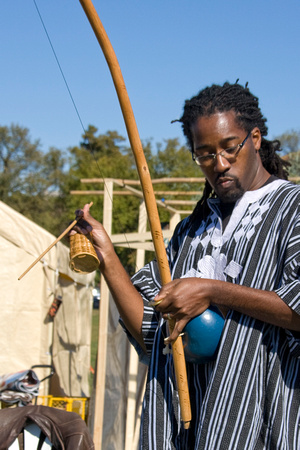850: Nkosi Ayize Playing the Berimbau
The berimbau de barriga, or simply berimbau, is a gourd-resonated, braced musical bow of African origin. The instrument consists of a 4'–5' (1.2 m–1.5 m) branch of biriba, bamboo, oak or other wood bent into an arc. The bow is strung with a single metal string, usually recycled from an industrial use.
Attached to the convex back of the bow with a small loop of string is a gourd resonator, although coconut, calabash or a tin can is occasionally substituted for a gourd. The string loop also serves as a bridge, dividing the metal string into two sections. The little finger of the musician’s left hand (assuming a right-handed player) passes underneath the string loop to hold the berimbau.
The string is struck with a thin stick called a vaquita or vareta, which is held in the player’s right hand along with a small basket rattle called caxixi. A small coin (dobrão) or stone (pedra) held between the musician’s left thumb and index finger is pressed to the string, resulting in a pitch change of about a minor or major second above the berimbau’s fundamental tone.
The berimbau originated in an early nineteenth-century Brazilian slave culture. Popular among African-Brazilian vendors and street musicians, these musical bows were known by African names such as urucungu, madimba lungungo, mbulumbumba, and hungu.


